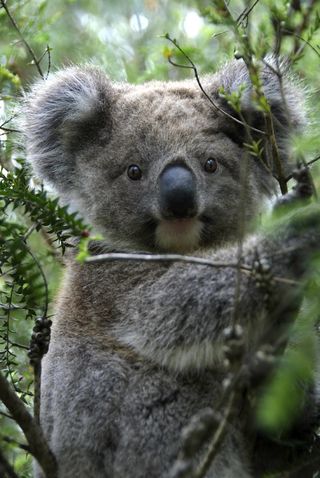
The mention of a koala bear often conjures up an image of an adorable spoon-nosed creature cocking its head to one side while clinging to a tree.
Now, scientists have figured out why the iconic Australian marsupials hug trees: The trunks help the koala bears keep cool, according to a new study.
"It can be a really useful way of getting rid of heat on a hot day," said study co-author Michael Kearney, an ecologist at the University of Melbourne in Australia.
Tree huggers
Given that koalas spend so much time in trees — the marsupials live in Australia's woodlands where they munch on leaves and sleep — nobody wondered why they hugged the trunks. People just thought they were taking a break on a more stable spot after eating leaves in the branches, Kearney said. [Marsupial Gallery: A Pouchful of Cute]
As such, the discovery came as a surprise. Kearney and his student, doctoral candidate Natalie Briscoe, were trying to predict how the woodland creatures on French Island, near Melbourne, would regulate their body temperatures as the continent heats up due to climate change. The region is cool most of the year, but during the summer, the temperature routinely spikes above 104 degrees Fahrenheit (40 degrees Celsius), Kearney said.
Briscoe measured wind and shade levels using a portable weather station, but didn't find any striking trends. Then she pointed to an infrared thermometer, which measures temperature based on thermal radiation, at the tree trunks the koalas were hugging. The trunks were considerably cooler than the ambient air temperature — sometimes by as much as 9 degrees F (5 degrees C), Kearney said.
Sign up for the Live Science daily newsletter now
Get the world’s most fascinating discoveries delivered straight to your inbox.
She also noticed the koalas clinging to acacia trees, even though they normally eat eucalyptus leaves. [See Images of the Tree-Hugging Koalas]
"As it got hotter the koalas went farther down the trees and started to really hug onto the tree trunks," Kearney told Live Science. "That seemed strange to us until we figured out that the trees are a bit cooler."
Stay cool
Koala bears pant to keep cool, letting evaporated moisture from their mouths carry heat away from their bodies.
When the team modeled koala bear heat transfer, they found the tree-dwellers save half the water they would have used panting if they hug trees instead.
Koalas get most of their water from their diet, but because eucalyptus leaves are laced with a toxin, the koalas can eat only a limited amount before the toxin harms the animals, Kearney said.
So tree-hugging could be critical to their survival on hot days, by allowing them to cool off without wasting precious water through panting, Kearney said.
It's not clear exactly why their preferred tree trunks are cool, but one possibility is that they pull in a lot of groundwater, which stays closer to the annual average air temperature, rather than the current air temperature, he said.
Climate change planning
Koalas' food (and hugging) trees will change their range with the hotter and drier weather brought by climate change, Bill Ellis, a wildlife researcher at the University of Queensland in Australia, who was not involved in the study, wrote in an email to Live Science.
But the new study suggests that food may be a smaller consideration in preserving koala habitat than previously thought, he said.
"As long as we plant trees koalas will eat, perhaps the other trees we plant just need to provide the right mix of shelter and heat sink characteristics," Ellis said. "It's quite an interesting concept, but non-native trees might be the future for koalas — as long as they also have the right fodder."
Farther north in the koala's range, the air is muggy and it feels hotter, so scientists should see how tree-hugging plays out in in different locations in the koala's habitat, Ellis said.
"Humidity means that the power of evaporation for cooling is reduced," Kearney said. So tree-hugging may be even more important up north, where evaporative cooling doesn't work as well, he said.
The study was published today (June 3) in the journal Biology Letters.
Follow Tia Ghose on Twitter and Google+. Follow Live Science @livescience, Facebook & Google+. Original article on Live Science.

Tia is the managing editor and was previously a senior writer for Live Science. Her work has appeared in Scientific American, Wired.com and other outlets. She holds a master's degree in bioengineering from the University of Washington, a graduate certificate in science writing from UC Santa Cruz and a bachelor's degree in mechanical engineering from the University of Texas at Austin. Tia was part of a team at the Milwaukee Journal Sentinel that published the Empty Cradles series on preterm births, which won multiple awards, including the 2012 Casey Medal for Meritorious Journalism.
